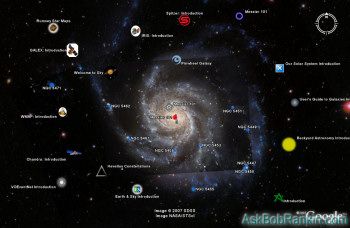What is Google Sky?
Google Sky is a virtual planetarium that is a part of the Google Earth software, which allows you to explore the cosmos from the comfort of your own PC. Read on to learn what you can discover with this and other astronomy software tools... |

Exploring the Night Sky
Google Sky is available as part of the latest version of Google Earth, (currently 4.2) which is a free download. The program is especially valuable for city dwellers that cannot simply go outside to stargaze because of light pollution but it also provides detailed information about the universe that is valuable for city and country folk alike.
Google Sky is fairly easy to navigate, having pretty much the same features as Earth. With a few minutes of exploration and patience you will be able to maneuver around the universe with the navigational tool located near the top right of the screen. The software includes many features that enable you to view and learn about constellations, galaxies, observatories and events that are currently happening in the universe. These features are called 'layers'. The layers allow you to control how much or how little information you want to have displayed at any given time. The layers can be added or removed by clicking the checkbox next to each folder. Currently the layers include the primary database, backyard astronomy, featured observatories, current events and educational materials. When the layers are enabled, clicking on any particular icon on your screen will cause a box to appear that has detailed information about the subject that you chose.
Switching from Google Earth to view Sky is simple. On the top right of your screen is an icon of the planet Saturn. Just click on this icon and you are taken to Sky. Whatever location that you input on Earth is the exact location overhead that you will be viewing in the cosmos. So if you want to see what the night sky would look like in Fabriano, Italy for example, type that location into the search box in Earth and then switch to Sky. You can then compare the night sky with another location, say for example Manhattan, NY.
 Using the navigational tool, you can virtually fly through the universe zooming in and out on points of interest either with or without the use of the layers. If you are unfamiliar with the stars you can use the sightseeing option which takes you on an automated tour of Sky. Simply pushing the play button on the control panel to your left will 'fly" you through the cosmos, stopping briefly at places such as the sky above the Eiffel Tower in France, Disney World in the U.S., Forbidden City, China, etc.
Using the navigational tool, you can virtually fly through the universe zooming in and out on points of interest either with or without the use of the layers. If you are unfamiliar with the stars you can use the sightseeing option which takes you on an automated tour of Sky. Simply pushing the play button on the control panel to your left will 'fly" you through the cosmos, stopping briefly at places such as the sky above the Eiffel Tower in France, Disney World in the U.S., Forbidden City, China, etc.
Whether you are a layperson or a serious astronomer, the Google Earth Community is a good place for discussions about Sky and also tips and tricks for enhancing your experience. You can subscribe to Google Earth's free monthly newsletter, Sightseer, which also offers highlights and new additions to the software, tips, contests and more.
Other Astronomy Software
For now the Earth portion of the software is superior to Sky but we can be pretty sure that Google will work to perfect Sky, making it more and more interactive, educational and entertaining. Currently, Google Sky doesn't have any particularly spectacular imagery of stars planets, nebulas or galaxies. For that, the Hubble Site is the place to go. With an extensive photo album and a video collection, images taken by the Hubble telescope are sure to amaze just about everyone. The Hubble Site also has a wealth of educational materials and image tours that include facts from an astronomy perspective, but you can't navigate through the sky like you can with Google's program.
There is also some buzz about a Microsoft project called WorldWide Telescope, which is supposed to be jaw-droppingly cool, blending images and data to allow for seamless panning and zooming across the night sky. The WWT website still says "Coming in Spring 2008" but for now the site offers only a teaser video with reactions from early testers.
There are other free programs for both Windows and Mac on the Internet that are similar to Google Sky. These include Stellarium, Open Universe, Celestia and many more. Check out this list of free Planetarium software for more details.
Post your comments about Google Sky and other astronomy software tools below...
|
|
|
This article was posted by Bob Rankin on 31 Mar 2008
| For Fun: Buy Bob a Snickers. |
|
Prev Article: Converting FAT to NTFS |
The Top Twenty |
Next Article: Automatic Backups |
Post your Comments, Questions or Suggestions
|
Free Tech Support -- Ask Bob Rankin Subscribe to AskBobRankin Updates: Free Newsletter Copyright © 2005 - Bob Rankin - All Rights Reserved About Us Privacy Policy RSS/XML |
Article information: AskBobRankin -- What is Google Sky? (Posted: 31 Mar 2008)
Source: https://askbobrankin.com/what_is_google_sky.html
Copyright © 2005 - Bob Rankin - All Rights Reserved



Most recent comments on "What is Google Sky?"
No comments have been posted on this article. Why not be the first?